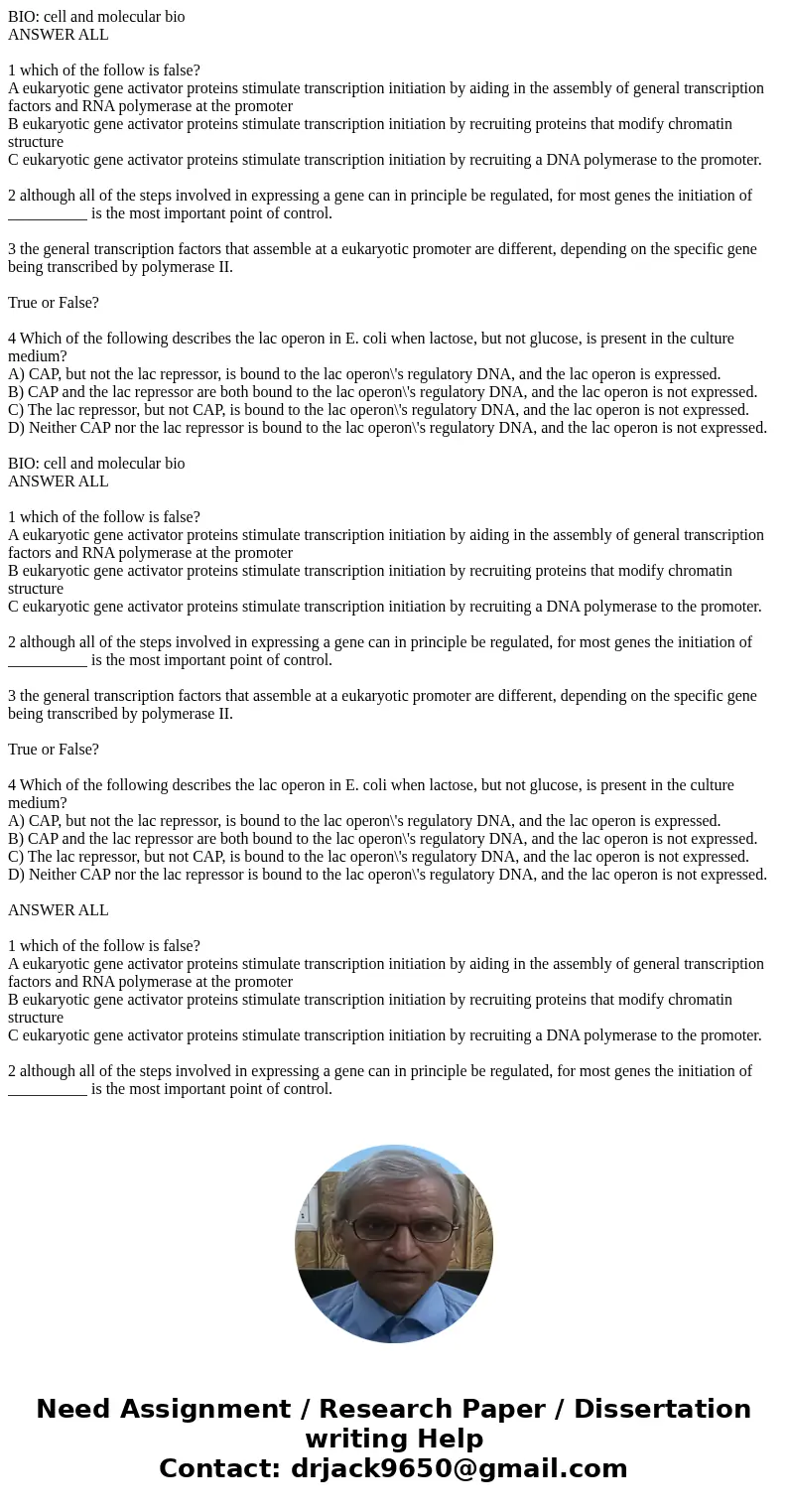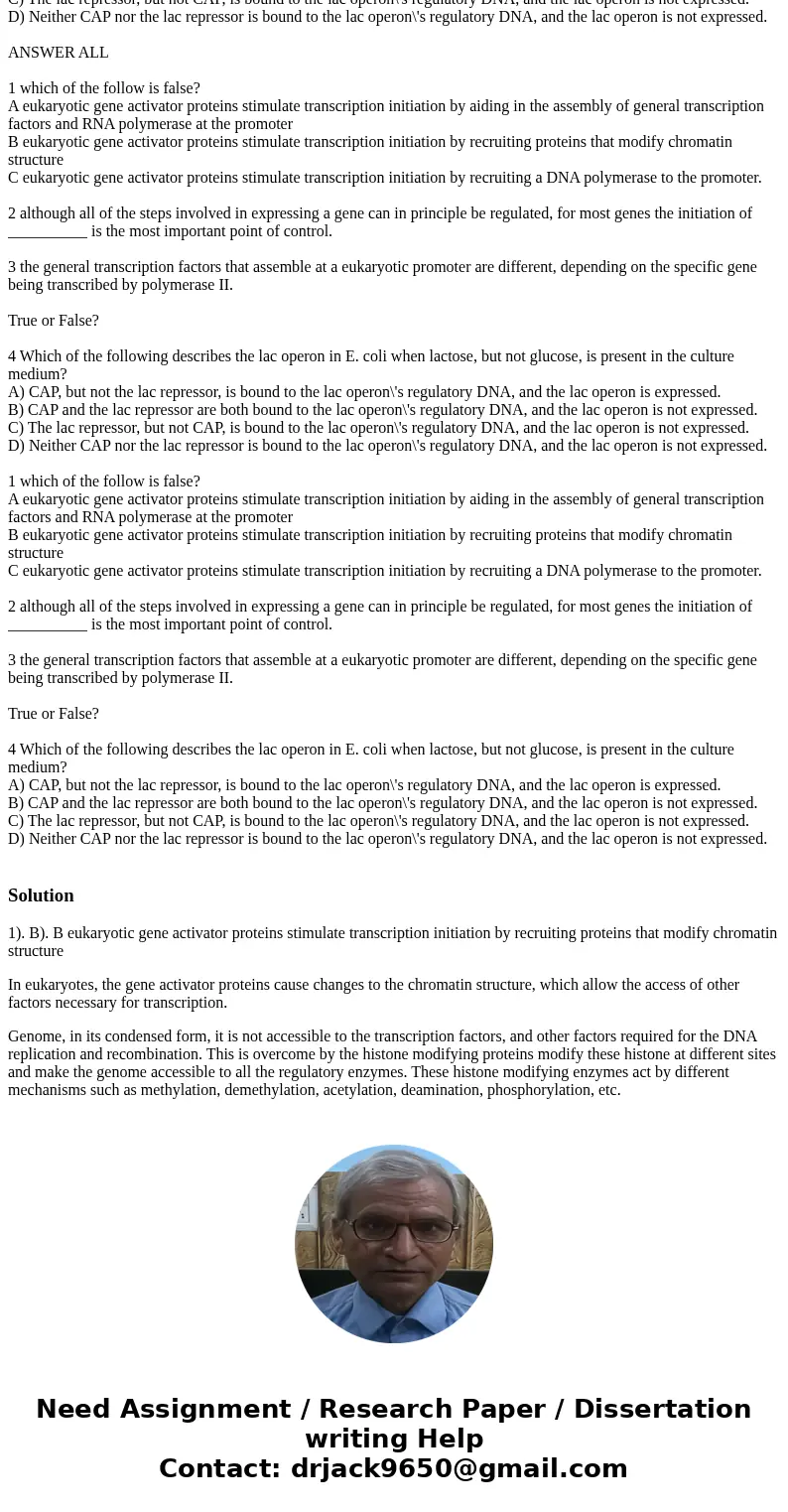BIO cell and molecular bio ANSWER ALL 1 which of the follow
BIO: cell and molecular bio
ANSWER ALL
1 which of the follow is false?
A eukaryotic gene activator proteins stimulate transcription initiation by aiding in the assembly of general transcription factors and RNA polymerase at the promoter
B eukaryotic gene activator proteins stimulate transcription initiation by recruiting proteins that modify chromatin structure
C eukaryotic gene activator proteins stimulate transcription initiation by recruiting a DNA polymerase to the promoter.
2 although all of the steps involved in expressing a gene can in principle be regulated, for most genes the initiation of __________ is the most important point of control.
3 the general transcription factors that assemble at a eukaryotic promoter are different, depending on the specific gene being transcribed by polymerase II.
True or False?
4 Which of the following describes the lac operon in E. coli when lactose, but not glucose, is present in the culture medium?
A) CAP, but not the lac repressor, is bound to the lac operon\'s regulatory DNA, and the lac operon is expressed.
B) CAP and the lac repressor are both bound to the lac operon\'s regulatory DNA, and the lac operon is not expressed.
C) The lac repressor, but not CAP, is bound to the lac operon\'s regulatory DNA, and the lac operon is not expressed.
D) Neither CAP nor the lac repressor is bound to the lac operon\'s regulatory DNA, and the lac operon is not expressed.
BIO: cell and molecular bio
ANSWER ALL
1 which of the follow is false?
A eukaryotic gene activator proteins stimulate transcription initiation by aiding in the assembly of general transcription factors and RNA polymerase at the promoter
B eukaryotic gene activator proteins stimulate transcription initiation by recruiting proteins that modify chromatin structure
C eukaryotic gene activator proteins stimulate transcription initiation by recruiting a DNA polymerase to the promoter.
2 although all of the steps involved in expressing a gene can in principle be regulated, for most genes the initiation of __________ is the most important point of control.
3 the general transcription factors that assemble at a eukaryotic promoter are different, depending on the specific gene being transcribed by polymerase II.
True or False?
4 Which of the following describes the lac operon in E. coli when lactose, but not glucose, is present in the culture medium?
A) CAP, but not the lac repressor, is bound to the lac operon\'s regulatory DNA, and the lac operon is expressed.
B) CAP and the lac repressor are both bound to the lac operon\'s regulatory DNA, and the lac operon is not expressed.
C) The lac repressor, but not CAP, is bound to the lac operon\'s regulatory DNA, and the lac operon is not expressed.
D) Neither CAP nor the lac repressor is bound to the lac operon\'s regulatory DNA, and the lac operon is not expressed.
ANSWER ALL
1 which of the follow is false?
A eukaryotic gene activator proteins stimulate transcription initiation by aiding in the assembly of general transcription factors and RNA polymerase at the promoter
B eukaryotic gene activator proteins stimulate transcription initiation by recruiting proteins that modify chromatin structure
C eukaryotic gene activator proteins stimulate transcription initiation by recruiting a DNA polymerase to the promoter.
2 although all of the steps involved in expressing a gene can in principle be regulated, for most genes the initiation of __________ is the most important point of control.
3 the general transcription factors that assemble at a eukaryotic promoter are different, depending on the specific gene being transcribed by polymerase II.
True or False?
4 Which of the following describes the lac operon in E. coli when lactose, but not glucose, is present in the culture medium?
A) CAP, but not the lac repressor, is bound to the lac operon\'s regulatory DNA, and the lac operon is expressed.
B) CAP and the lac repressor are both bound to the lac operon\'s regulatory DNA, and the lac operon is not expressed.
C) The lac repressor, but not CAP, is bound to the lac operon\'s regulatory DNA, and the lac operon is not expressed.
D) Neither CAP nor the lac repressor is bound to the lac operon\'s regulatory DNA, and the lac operon is not expressed.
1 which of the follow is false?
A eukaryotic gene activator proteins stimulate transcription initiation by aiding in the assembly of general transcription factors and RNA polymerase at the promoter
B eukaryotic gene activator proteins stimulate transcription initiation by recruiting proteins that modify chromatin structure
C eukaryotic gene activator proteins stimulate transcription initiation by recruiting a DNA polymerase to the promoter.
2 although all of the steps involved in expressing a gene can in principle be regulated, for most genes the initiation of __________ is the most important point of control.
3 the general transcription factors that assemble at a eukaryotic promoter are different, depending on the specific gene being transcribed by polymerase II.
True or False?
4 Which of the following describes the lac operon in E. coli when lactose, but not glucose, is present in the culture medium?
A) CAP, but not the lac repressor, is bound to the lac operon\'s regulatory DNA, and the lac operon is expressed.
B) CAP and the lac repressor are both bound to the lac operon\'s regulatory DNA, and the lac operon is not expressed.
C) The lac repressor, but not CAP, is bound to the lac operon\'s regulatory DNA, and the lac operon is not expressed.
D) Neither CAP nor the lac repressor is bound to the lac operon\'s regulatory DNA, and the lac operon is not expressed.
Solution
1). B). B eukaryotic gene activator proteins stimulate transcription initiation by recruiting proteins that modify chromatin structure
In eukaryotes, the gene activator proteins cause changes to the chromatin structure, which allow the access of other factors necessary for transcription.
Genome, in its condensed form, it is not accessible to the transcription factors, and other factors required for the DNA replication and recombination. This is overcome by the histone modifying proteins modify these histone at different sites and make the genome accessible to all the regulatory enzymes. These histone modifying enzymes act by different mechanisms such as methylation, demethylation, acetylation, deamination, phosphorylation, etc.


 Homework Sourse
Homework Sourse